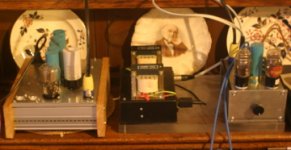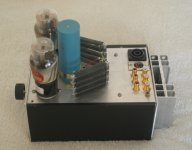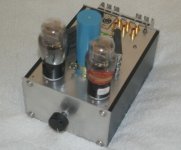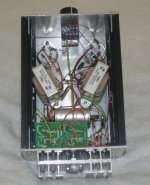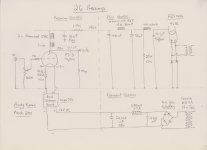Vinysavor
Off topic...
I see your location is Lindau. If this is Lindau at the shores of Bodensee in the south of Germany, I go there every summer! Nice place!
I have of course also "burnt" some money in Spielbank Lindau and Konstanz (casinos).😉
Off topic...
I see your location is Lindau. If this is Lindau at the shores of Bodensee in the south of Germany, I go there every summer! Nice place!
I have of course also "burnt" some money in Spielbank Lindau and Konstanz (casinos).😉
Hi!
Yes I live in Lindau / Bodensee. You can see the lake in the background of some of the photos on my blog. Next time you are here, drop me a mail and we can meet up!
Thomas
Vinysavor
Off topic...
I see your location is Lindau. If this is Lindau at the shores of Bodensee in the south of Germany, I go there every summer! Nice place!
Yes I live in Lindau / Bodensee. You can see the lake in the background of some of the photos on my blog. Next time you are here, drop me a mail and we can meet up!
Thomas
Who's using plate chokes in their 26 preamps? I've been playing about with four 156C Hammond chokes - 150H at 8mA - using them in series as pairs. I put them bottom-to-bottom and wired them out of phase since I read that somewhere. Resistance in series is 7K.
Sound is damn good! Quite surprising. I'm using Teflon FT-3 output caps and filament bias with 10 ohm resistors. 140v on the plate, 10v on cathode. Rod Coleman filament supply - his original one which was posted early on in these pages. This is a really cheap and effective way to build a 26 preamp, except that in my case I'm using choke input supply to Rod's boards with a 280mH choke, 2.7A, and 20,000uf caps.
Now I know that this works I can look at some more exotic plate chokes!! I was thinking output transformer, but Thomas is always telling me to have more inductance and it really does sound very clean.
Andy
Sound is damn good! Quite surprising. I'm using Teflon FT-3 output caps and filament bias with 10 ohm resistors. 140v on the plate, 10v on cathode. Rod Coleman filament supply - his original one which was posted early on in these pages. This is a really cheap and effective way to build a 26 preamp, except that in my case I'm using choke input supply to Rod's boards with a 280mH choke, 2.7A, and 20,000uf caps.
Now I know that this works I can look at some more exotic plate chokes!! I was thinking output transformer, but Thomas is always telling me to have more inductance and it really does sound very clean.
Andy
I know you have another thread on this. But just go for the Lundahl. Their 1667 is excellent and available of the shelf. You can always try a parafeed transformer. And then you get to keep the plate choke. Just another avenue to consider.Now I know that this works I can look at some more exotic plate chokes!! I was thinking output transformer, but Thomas is always telling me to have more inductance and it really does sound very clean.
Here's a picture of my 26 preamp. Power supply on left - AZ1 mesh, choke input, motor run caps. Middle is filament supply with two large 280mH chokes for choke input. Preamp on right is tiny! Rod Coleman boards, filament bias with a 10 ohm resistor. Sounds very nice. The preamp bit is ultra cheap - just four Hammond 156C plate chokes, wired in series in pairs with FT-3 cap outputs. Chap on the plate is Disraeli.
andy
andy
Attachments
Here's a picture of my 26 preamp. Power supply on left - AZ1 mesh, choke input, motor run caps. Middle is filament supply with two large 280mH chokes for choke input. Preamp on right is tiny! Rod Coleman boards, filament bias with a 10 ohm resistor. Sounds very nice. The preamp bit is ultra cheap - just four Hammond 156C plate chokes, wired in series in pairs with FT-3 cap outputs. Chap on the plate is Disraeli.
andy
Very nice. What does the 10 ohm resistor do?
With filament bias the filament supply is connected between one side of the filament and ground. The other side of the filament has the 10 ohm resistor going to ground. So the filament supply goes through both the tube and the cathode resistor. This can sound really excellent, but only on condition that the filament supply is really pure and clean, since the signal goes through it. Compromise the filament supply and the sound can get sharp or gritty - some people have tried and rejected this, but I suspect they really needed a no-compromise filament supply. You can see the size of the filament chokes I use!!
Andy
Andy
Here's a picture of my 26 preamp. Power supply on left - AZ1 mesh, choke input, motor run caps. Middle is filament supply with two large 280mH chokes for choke input. Preamp on right is tiny! Rod Coleman boards, filament bias with a 10 ohm resistor. Sounds very nice. The preamp bit is ultra cheap - just four Hammond 156C plate chokes, wired in series in pairs with FT-3 cap outputs. Chap on the plate is Disraeli.
andy
Thanks to share, could you post the schematic used?
Felipe
And do you have a bigger picture? The current one is hardly larger than the thumbnail. 🙂
And perhaps a picture of the guts?
And perhaps a picture of the guts?
Yes, the verbal description of the circuit does not help that much, since it is kinda complex too....
Andy, it looks splendid.
I particularly like the stacked array of Vitreous enamel resistors.
Is that the LCR motor cap in the blue plastic enclosure? If so, may I humbly recommend a go on their newly-acquired AMPOHM audio MKPs? These are HUGELY better than the motor-type, in my trials.
The motor series pay no heed to mechanical resonances, and the sound really varies according to whether they were wound tightly (e.g.: before important football match) or slack (Friday afternoon).
AMPOHM WOUND PRODUCTS|FP-CA-30-AU|AUDIO CAPACITOR, 30UF, 630V | Farnell United Kingdom
I particularly like the stacked array of Vitreous enamel resistors.
Is that the LCR motor cap in the blue plastic enclosure? If so, may I humbly recommend a go on their newly-acquired AMPOHM audio MKPs? These are HUGELY better than the motor-type, in my trials.
The motor series pay no heed to mechanical resonances, and the sound really varies according to whether they were wound tightly (e.g.: before important football match) or slack (Friday afternoon).
AMPOHM WOUND PRODUCTS|FP-CA-30-AU|AUDIO CAPACITOR, 30UF, 630V | Farnell United Kingdom
Nice preamp Andy, but isn't the o/p cap value (0.1u) a bit too low?
Those Russian teflons are available up to 0.47uF/200 V, a couple of those are on my desk right now 😉
Huge and heavy, 180 grs each.
Those Russian teflons are available up to 0.47uF/200 V, a couple of those are on my desk right now 😉
Huge and heavy, 180 grs each.
Nice preamp Andy, but isn't the o/p cap value (0.1u) a bit too low?
With the 1 Meg resistor corner frequency is 1,6 Hz; is that low enough?
Maybe with an input resistance of the power amp paralleled it will go up a bit.
Andy, it looks splendid.
I particularly like the stacked array of Vitreous enamel resistors.
Is that the LCR motor cap in the blue plastic enclosure? If so, may I humbly recommend a go on their newly-acquired AMPOHM audio MKPs? These are HUGELY better than the motor-type, in my trials.
The motor series pay no heed to mechanical resonances, and the sound really varies according to whether they were wound tightly (e.g.: before important football match) or slack (Friday afternoon).
AMPOHM WOUND PRODUCTS|FP-CA-30-AU|AUDIO CAPACITOR, 30UF, 630V | Farnell United Kingdom
X2, or the Mundorf Tube-Caps. 😉
Here's the schematic. Still grappling with scanner software so may not be optimum - we'll see. Please point out any errors
Andy
About PSU: under AZ1 are two diodes? values & type?
For 10uF MKP I prefer Auricap.
With the 1 Meg resistor corner frequency is 1,6 Hz; is that low enough?
Maybe with an input resistance of the power amp paralleled it will go up a bit.
When your 1M R is in parallel to a 100K load its value becomes 90.91K and when in parallel with 50K equals to 47.62K
I would consider those values only when you calculate the corner freq. (17.5 and 35.5 Hz)
When your 1M R is in parallel to a 100K load its value becomes 90.91K and when in parallel with 50K equals to 47.62K
I would consider those values only when you calculate the corner freq. (17.5 and 35.5 Hz)
Of course you are right.
I guess Andy is aware of this.
- Home
- Amplifiers
- Tubes / Valves
- #26 pre amp
